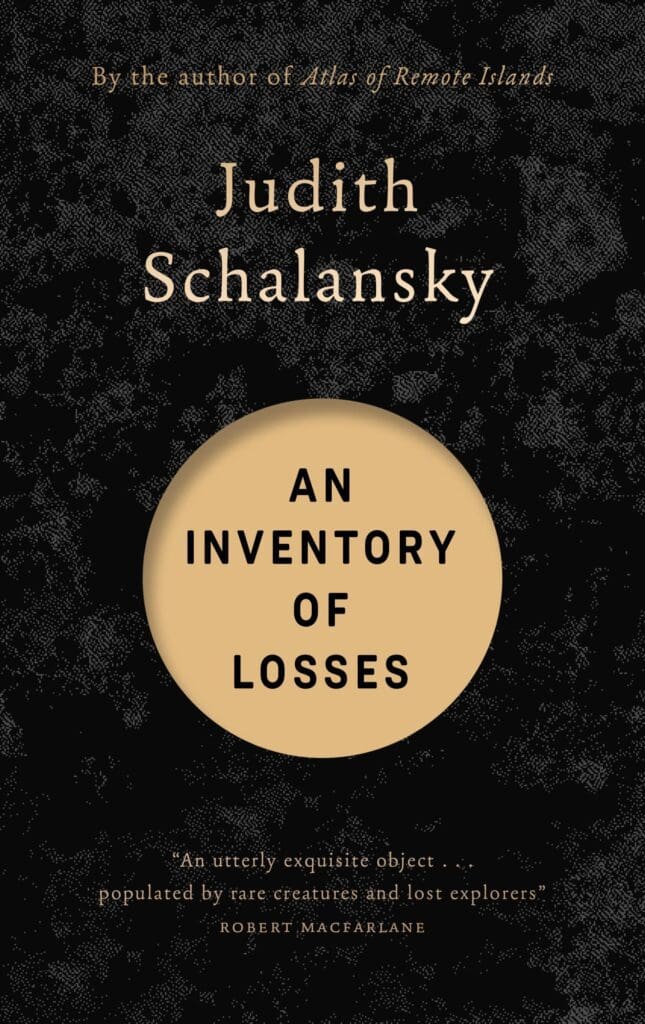In the human endeavor of preservation, there is an intimate relationship between memory and those tasked with preserving it. In his essay “Between Memory and History: Les Lieux de Mémoire,” French historian Pierre Nora writes that “today…professional archivists have learned that the essence of their trade is the art of controlled destruction.” Among other things, this suggests that a true archivist has a love for not only what remains in the archive, but also what is lost. Memory is an art—the artist the recaller but also the forgetter.
Judith Schalansky’s An Inventory of Losses (238 pages; New Directions), newly translated into English by Jackie Smith, is a spell-binding meditation on the instinctive desire of humans to preserve everything despite the fact that everything will inevitably be lost. The book is divided into twelve sections, each dedicated to a specific place, animal, or cultural artifact that no longer exists, such as a small island called Tuanaki or the Seven Books of Mani. Yet the title of “inventory” is an understatement. Schalansky does not simply describe these lost things and their histories like one would in a catalog or encyclopedia. Rather, she preserves the old by creating it anew.
Each chapter offers a vivid, living experience of these monuments that can no longer be experienced in the physical world. Schalansky is not shy about the full implications of death and loss; she knows that “every item is already waste, every building already a ruin, and all creation nothing but destruction, and the same is true of the work of all those disciplines and institutions that claim to be preserving the legacy of humanity.” Like Pierre Nora, she understands her work as the artist and archivist is not to blindly save anything and everything that has ever existed—instead, she must selectively pick from the innumerable items of the past, and re-imbue her choices with new meaning.
As readers of this remembering project,we are taken on a wonderful journey through time and space, seeing with new eyes things we will never get to see. We watch the Caspian Tiger, which became extinct around the 1960s, fighting in the glorious yet brutal arenas of Ancient Rome. In the chapter on the Villa Sacchetti, a mansion almost completely eroded and demolished by the mid-eighteenth century, we follow the life of a young Hubert Robert as he travels through Italy painting architectural ruins. And, one of my favorites: Schalansky’s lament of a lost Caspar David Friedrich painting depicting a harbor in Greifswald, which is simply a long, vibrant description of the wildlife on the path leading to the harbor.
Through these alternate depictions of the things we have lost, we see that An Inventory of Losses is both a lament for and a celebration of beauty. Schalansky’s prose is reflective in places and exuberant in others; she balances the mourning of death with the commemoration of life. Even the object of the book itself shows that this is an archive made out of the love for what it contains: the text has a simple but elegant matte hard cover, the title and author’s name inset in silver against a black and gray pixelated design. Flipping through the pages, we notice that each of the twelve sections is divided by a sheet of paper that is, at first glance, black. However, upon looking closer, we see that the page has the faint image of the following chapter’s subject, its outline a dark gray against black.
These spectral traces of creatures, places, and objects are subtle yet powerful reminders of what An Inventory of Losses sets out to do: preserve the lingering impressions of what will soon fade. As Schalansky notes:
This book, like all others, springs from the desire to have something survive, to bring the past into the present, to call to mind the forgotten, to give voice to the silenced, and to mourn the lost. Writing cannot bring anything back, but it can enable everything to be experienced. Hence this volume is as much about seeking as finding, as much about losing as gaining, and gives a sense that the difference between presence and absence is perhaps marginal, as long as there is memory.
While a single book cannot fully give life to something that is gone, it can still use it to create something new and beautiful again. The faint images in the book appear as though they are literally fading—for some of them, we have to squint to make them out. But as long as they are there, they have the power to transform us. The chapters in An Inventory of Losses are ghosts: wisps of their former selves, haunting the present with the faint sketch of what once was.


One thought on “‘An Inventory of Losses’ by Judith Schalansky: The Innumerable Items of the Past”